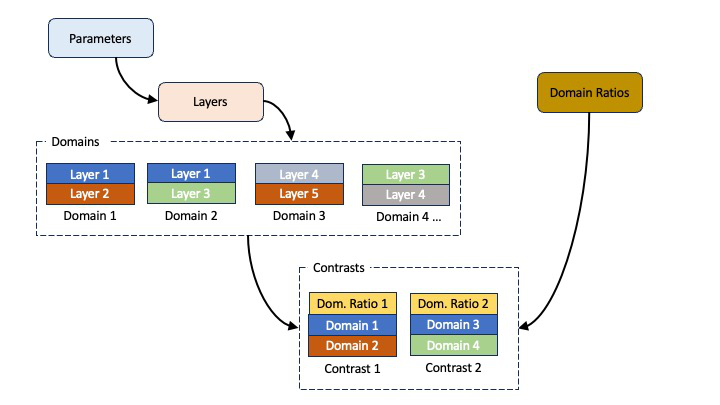Standard Layers Domains#
Note
See the /examples/domains/standardLayers/ folder for an example of standard layers with domains.
In order to use domains, we create a project of the correct type….
problem = createProject(calcType='domains');
problem = RAT.Project(calculation='domains')
The principle of setting up these calculations relies on firstly grouping the layers into domains, then grouping the defined domains intro contrasts, according to a ‘domain ratio’ parameter:

The example (in the examples folder), we define the layers as for conventional Standard Layers projects:
Layer1 = {'Layer 1',... % Name of the layer
'L1 thick',... % Layer thickness
'L1 SLD',... % Layer SLD
'L1 Rough',... % Layer roughness
'L1 Hydr',... % hydration (percent)
'bulk out' };
Layer2 = {'Layer 2',... % Name of the layer
'L2 thick',... % Layer thickness
'L2 SLD',... % Layer SLD
'L2 Rough',... % Layer roughness
'L2 Hydr',... % hydration (percent)
'bulk out' };
Layer3 = {'Layer 3',... % Name of the layer
'L3 thick',... % Layer thickness
'L3 SLD',... % Layer SLD
'L3 Rough',... % Layer roughness
'L3 Hydr',... % hydration (percent)
'bulk out' };
problem.addLayerGroup({Layer1, Layer2, Layer3});
# Now group these parameters into layers
problem.layers.append(name='Layer 1', thickness='L1 Thickness', SLD='L1 SLD', roughness='L1 Roughness',
hydration='L1 Hydration', hydrate_with='bulk out')
problem.layers.append(name='Layer 2', thickness='L2 Thickness', SLD='L2 SLD', roughness='L2 Roughness',
hydration='L2 Hydration', hydrate_with='bulk out')
problem.layers.append(name='Layer 3', thickness='L3 Thickness', SLD='L3 SLD', roughness='L3 Roughness',
hydration='L3 Hydration', hydrate_with='bulk out')
p Name Thickness SLD Roughness Hydration Hydrate with
_ _________ __________ ________ __________ _________ ____________
1 "Layer 1" "L1 thick" "L1 SLD" "L1 Rough" "L1 Hydr" "bulk out"
2 "Layer 2" "L2 thick" "L2 SLD" "L2 Rough" "L2 Hydr" "bulk out"
3 "Layer 3" "L3 thick" "L3 SLD" "L3 Rough" "L3 Hydr" "bulk out"
+-------+---------+--------------+--------+--------------+--------------+--------------+
| index | name | thickness | SLD | roughness | hydration | hydrate with |
+-------+---------+--------------+--------+--------------+--------------+--------------+
| 0 | Layer 1 | L1 Thickness | L1 SLD | L1 Roughness | L1 Hydration | bulk out |
| 1 | Layer 2 | L2 Thickness | L2 SLD | L2 Roughness | L2 Hydration | bulk out |
| 2 | Layer 3 | L3 Thickness | L3 SLD | L3 Roughness | L3 Hydration | bulk out |
+-------+---------+--------------+--------+--------------+--------------+--------------+
From this point, the model diverges from the usual Standard Layers case, in that these are grouped into ‘domain contrasts’, which appears in an additional table in the printout of the project class. Domains contrasts consist of only layers, with no bulk phases etc..
p 1
___________________ ________________
"Name" "Domain Test"
"Data" "Simulation"
"Background" "Background 1"
"Background Action" "add"
"Bulk in" "SLD Air"
"Bulk out" "SLD D2O"
"Scalefactor" "Scalefactor 1"
"Resolution" "Resolution 1"
"Resample" "false"
"Domain Ratio" "Domain Ratio 1"
"Model" "Domain1"
"" "Domain2"
+-------+-------------+------------+--------------+-------------------+---------+----------+---------------+--------------+----------+----------------+----------+
| index | name | data | background | background action | bulk in | bulk out | scalefactor | resolution | resample | domain ratio | model |
+-------+-------------+------------+--------------+-------------------+---------+----------+---------------+--------------+----------+----------------+----------+
| 0 | Domain Test | Simulation | Background 1 | add | SLD Air | SLD D2O | Scalefactor 1 | Resolution 1 | False | Domain Ratio 1 | Domain 1 |
| | | | | | | | | | | | Domain 2 |
+-------+-------------+------------+--------------+-------------------+---------+----------+---------------+--------------+----------+----------------+----------+
It is then these that are grouped into the final contrasts model. For each contrast, there must be two (and only two) domain contrasts. In addition, each contrast requires a Domain Ratio parameter. This is a fittable parameter between 0 and 1, that appears in the Domain Ratio table:
p Name Min Value Max Fit?
_ ________________ ___ _____ ___ _____
1 "Domain Ratio 1" 0.4 0.5 0.6 false
+-------+----------------+-----+-------+-----+-------+
| index | name | min | value | max | fit |
+-------+----------------+-----+-------+-----+-------+
| 0 | Domain Ratio 1 | 0.4 | 0.5 | 0.6 | False |
+-------+----------------+-----+-------+-----+-------+
leading to the final contrast structure of two domains, and one domain ratio:
p 1 2
_______ _________ _________
"Name" "Domain1" "Domain2"
"Model" "Layer 1" "Layer 2"
"" "" "Layer 3"
+-------+----------+---------+
| index | name | model |
+-------+----------+---------+
| 0 | Domain 1 | Layer 1 |
| 1 | Domain 2 | Layer 2 |
| | | Layer 3 |
+-------+----------+---------+
Note
For domain ratio, a ratio of 0 means 100% Domain 1, whilst conversely a ratio of 1 means 100% Domain 2.
